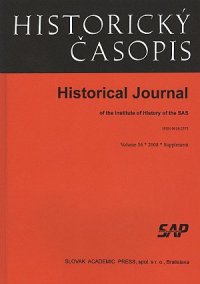The military intervention of the central government in Slovakia, 9-11 March 1939
The military intervention of the central government in Slovakia, 9-11 March 1939
Author(s): Valerián BystrickýSubject(s): History
Published by: SAV - Slovenská akadémia vied - Historický ústav SAV
Keywords: History; Hlinka’s Slovak People’s Party; Slovakia; Hlinka Guard; Prague; Bratislava; autonomy; intervention
Summary/Abstract: The military intervention of the Prague central government in Slovakia during the days from 9 to 11 March 1939 was intended to prevent the internal disintegration of Czecho-Slovakia. It would achieve this by replacing the autonomous government of J. Tiso and limiting the separatist tendencies of the radical members of Hlinka’s Slovak People’s Party and the para-military Hlinka Guard. However, the military coup was not thoroughly prepared from the military, political or propaganda points of view. After the initial successes of the Czech gendarmes, who penetrated into Slovakia on the evening of 9 March, the Hlinka Guard began to organize resis-tance and present the coup as an attempt to reverse the results of the Act on the Autonomy of the Slovak Region from 2 November 1938 and return to the centralist regime in Slovakia. In the struggle for public opinion, the Prague government could not convince the public about its intentions, and pressure from the People’s Party and Hlinka Guard forced it to hand over power to the political representatives of the Slovak region on the afternoon of 11 March. During the evening of 11 March President E. Hácha appointed K. Sidor as the new premier of the autonomous government. Sidor began the work of political consolidation. He enforced the release of imprisoned members of the Hlinka Guard and representatives of the People’s Party. He also forced the government in Prague to make various political concessions, which increased the legal powers of the autonomous government in Bratislava. The military intervention in Slovakia worsened relations between the Czechs and Slovaks. Adolf Hitler used the situation to achieve the internal break up of the republic. Berlin unambiguously supported the demand for the creation of a Slovak state. The Parliament of the Slovak Region declared an independent state on 14 March 1939. This began the process of internal disintegration of Czecho-Slovakia, which led to the occupation of Sub-Carpathian Ruthenia by Hungary and the occupation of Bohemia and Moravia by Nazi Germany on 15 March.
Journal: Historický časopis
- Issue Year: 2011
- Issue No: Supplement
- Page Range: 77-110
- Page Count: 34
- Language: English

